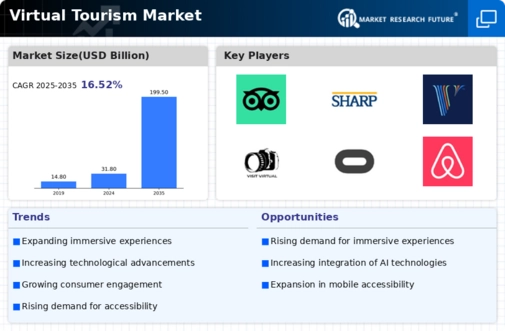Consumer Demand for Unique Experiences
The Virtual Tourism Market is increasingly driven by consumer demand for unique and personalized experiences. Modern travelers are seeking alternatives to traditional tourism, favoring experiences that offer cultural immersion and exploration without the constraints of physical travel. Data suggests that 70% of consumers express interest in virtual experiences that allow them to explore historical sites, art galleries, and natural wonders from their homes. This shift in consumer preferences indicates a potential for growth in the Virtual Tourism Market, as providers adapt to meet these evolving demands. By offering tailored virtual experiences, companies can attract a diverse audience, including those with mobility challenges or time constraints, thereby expanding their market reach.
Increased Accessibility and Affordability
Accessibility and affordability are pivotal drivers in the Virtual Tourism Market. As technology becomes more widespread, the cost of VR equipment and software is decreasing, making virtual tourism experiences available to a larger demographic. Reports indicate that the number of households with VR headsets is expected to double by 2026, suggesting a growing market for virtual travel experiences. This democratization of technology allows individuals who may not have the means to travel physically to explore destinations virtually. Furthermore, the rise of mobile applications that offer virtual tours at minimal costs is likely to attract budget-conscious consumers. As a result, the Virtual Tourism Market is poised to expand as more people engage with virtual travel options.
Sustainability and Environmental Awareness
Sustainability is becoming a crucial consideration in the Virtual Tourism Market. As awareness of environmental issues grows, many consumers are seeking eco-friendly travel options. Virtual tourism presents a sustainable alternative, allowing individuals to explore destinations without contributing to carbon emissions associated with traditional travel. The Virtual Tourism Market can capitalize on this trend by promoting the environmental benefits of virtual experiences. Reports indicate that 60% of travelers are more likely to choose sustainable options, suggesting a significant market opportunity. By emphasizing the reduced environmental impact of virtual tourism, companies can attract environmentally conscious consumers and position themselves as leaders in sustainable travel solutions.
Technological Advancements in Virtual Reality
The Virtual Tourism Market is experiencing a surge in technological advancements, particularly in virtual reality (VR) and augmented reality (AR). These technologies enhance user experiences by providing immersive environments that simulate real-world locations. As of 2025, the VR market is projected to reach approximately 44 billion USD, indicating a robust growth trajectory. This growth is likely to drive the Virtual Tourism Market, as more consumers seek engaging and interactive travel experiences from the comfort of their homes. The integration of high-definition graphics, 360-degree video, and haptic feedback systems further enriches the virtual travel experience, making it more appealing to a broader audience. Consequently, the demand for innovative VR solutions is expected to propel the Virtual Tourism Market forward.
Integration of Social Features in Virtual Platforms
The integration of social features in virtual tourism platforms is emerging as a key driver in the Virtual Tourism Market. As consumers increasingly seek social interaction, platforms that facilitate shared experiences are gaining traction. Features such as virtual group tours, live interactions with local guides, and social media integration enhance the appeal of virtual tourism. Data indicates that platforms offering social engagement see a 30% higher user retention rate, suggesting that community-driven experiences are vital for sustained interest. This trend indicates that the Virtual Tourism Market may evolve to prioritize social connectivity, thereby attracting users who value shared experiences and community engagement in their virtual travels.


















Leave a Comment